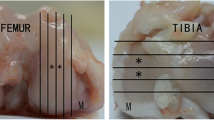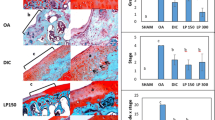Abstract
The aim of this study was to investigate the effects of intra-articular injection of dehydroepiandrosterone (DHEA) on cartilage and synovium of knee joints with osteoarthritis (OA) in rabbits and the underlying mechanism. Forty rabbits underwent unilateral anterior cruciate ligament transaction and were divided into two groups. Rabbits were injected with 100 μmol/l DHEA dissolved in the dimethylsulphoxide (DMSO) in the knee joints 5 weeks after transaction, once a week for 5 weeks. Rabbits injected with DMSO under the same condition were served as a control. All rabbits were killed 1 week after the last injection. The knee joints were evaluated by gross morphology, histology, and gene expression analysis. Gross morphologic inspection and histological evaluation showed that the DHEA group appeared less damage in cartilage and synovium as compared with the control. Gene expression analysis revealed that the mRNA expression of matrix metalloproteinase-3 (MMP-3) in cartilage and synovium decreased significantly in the DHEA group and that of tissue inhibitor of metalloproteinase-1 (TIMP-1) increased. No significant difference of interleukin-1 beta (IL-1β) mRNA expression was found in the cartilage between two groups while the mRNA expression of IL-1β in the synovium was largely suppressed in the DHEA group. The study suggests that DHEA plays a protective role against cartilage degradation and synovium inflammation in rabbits with OA. This role may be achieved through the regulation of the MMP-3, TIMP-1, and IL-1β gene expression in the cartilage and synovium.


Similar content being viewed by others
References
Creamer P, Hochberg MC (1997) Osteoarthritis. Lancet 350:503–508
Caron JP, Fernandes JC, Martel-Pelletier J, Tardif G, Mineau F, Geng C et al (1996) Chondroprotective effect of intraarticular injections of interleukin-1 receptor antagonist in experimental osteoarthritis. Suppression of collagenase-1 expression. Arthritis Rheum 39:1535–1544
Bramono DS, Richmond JC, Weitzel PP, Kaplan DL, Altman GH (2004) Matrix metalloproteinases and their clinical applications in orthopaedics. Clin Orthop Relat Res 428:272–285
Tamblyn R, Berkson L, Dauphinee WD, Gayton D, Grad R, Huang A et al (1997) Unnecessary prescribing of NSAIDs and the management of NSAID-related gastropathy in medical practice. Ann Intern Med 127:429–438
Smalley WE, Ray WA, Daugherty JR, Griffin MR (1995) Nonsteroidal anti-inflammatory drugs and the incidence of hospitalizations for peptic ulcer disease in elderly persons. Am J Epidemiol 141:539–545
Orentreich N, Brind JL, Rizer RL, Vogelman JH (1984) Age changes and sex differences in serum dehydroepiandrosterone sulfate concentrations throughout adulthood. J Clin Endocrinol Metab 59:551–555
Belanger A, Candas B, Dupont A, Cusan L, Diamond P, Gomez JL et al (1994) Changes in serum concentrations of conjugated and unconjugated steroids in 40- to 80-year-old men. J Clin Endocrinol Metab 79:1086–1090
Coleman DL, Schwizer RW, Leiter EH (1984) Effect of genetic background on the therapeutic effects of dehydroepiandrosterone (DHEA) in diabetes-obesity mutants and in aged normal mice. Diabetes 33:26–32
Chang DM, Lan JL, Lin HY, Luo SF (2002) Dehydroepiandrosterone treatment of women with mild-to-moderate systemic lupus erythematosus: a multicenter randomized, double-blind, placebo-controlled trial. Arthritis Rheum 46:2924–2927
de la Torre B, Hedman M, Nilsson E, Olesen O, Thorner A (1993) Relationship between blood and joint tissue DHEAS levels in rheumatoid arthritis and osteoarthritis. Clin Exp Rheumatol 11:597–601
Alexandersen P, Haarbo J, Christiansen C (1996) The relationship of natural androgens to coronary heart disease in males: a review. Atherosclerosis 125:1–13
Zumoff B, Levin J, Rosenfeld RS, Markham M, Strain GW, Fukushima DK (1981) Abnormal 24-hr mean plasma concentrations of dehydroisoandrosterone and dehydroisoandrosterone sulfate in women with primary operable breast cancer. Cancer Res 41:3360–3363
Turner RT, Lifrak ET, Beckner M, Wakley GK, Hannon KS, Parker LN (1990) Dehydroepiandrosterone reduces cancellous bone osteopenia in ovariectomized rats. Am J Physiol 258:E673–E677
Jo H, Park JS, Kim EM, Jung MY, Lee SH, Seong SC et al (2003) The in vitro effects of dehydroepiandrosterone on human osteoarthritic chondrocytes. Osteoarthr Cartil 11:585–594
Jo H, Ahn HJ, Kim EM, Kim HJ, Seong SC, Lee I et al (2004) Effects of dehydroepiandrosterone on articular cartilage during the development of osteoarthritis. Arthritis Rheum 50:2531–2538
Yoshioka M, Coutts RD, Amiel D, Hacker SA (1996) Characterization of a model of osteoarthritis in the rabbit knee. Osteoarthr Cartil 4:87–98
Pelletier JP, Jovanovic D, Fernandes JC, Manning P, Connor JR, Currie MG et al (1998) Reduced progression of experimental osteoarthritis in vivo by selective inhibition of inducible nitric oxide synthase. Arthritis Rheum 41:1275–1286
Mankin HJ, Dorfman H, Lippiello L, Zarins A (1971) Biochemical and metabolic abnormalities in articular cartilage from osteo-arthritic human hips. II. Correlation of morphology with biochemical and metabolic data. J Bone Joint Surg Am 53:523–537
Yoshimi T, Kikuchi T, Obara T, Yamaguchi T, Sakakibara Y, Itoh H et al (1994) Effects of high-molecular-weight sodium hyaluronate on experimental osteoarthrosis induced by the resection of rabbit anterior cruciate ligament. Clin Orthop Relat Res 298:296–304
Brandt KD, Braunstein EM, Visco DM, O’Connor B, Heck D, Albrecht M (1991) Anterior (cranial) cruciate ligament transection in the dog: a bona fide model of osteoarthritis, not merely of cartilage injury and repair. J Rheumatol 18:436–446
Sommerlath K, Gillquist J (1993) The effects of an artificial meniscus substitute in a knee joint with a resected anterior cruciate ligament. An experimental study in rabbits. Clin Orthop Relat Res 289:276–284
Hill CL, Gale DG, Chaisson CE, Skinner K, Kazis L, Gale ME et al (2001) Knee effusions, popliteal cysts, and synovial thickening: association with knee pain in osteoarthritis. J Rheumatol 28:1330–1337
Smith MD, Triantafillou S, Parker A, Youssef PP, Coleman M (1997) Synovial membrane inflammation and cytokine production in patients with early osteoarthritis. J Rheumatol 24:365–371
Araghi-Niknam M, Liang B, Zhang Z, Ardestani SK, Watson RR (1997) Modulation of immune dysfunction during murine leukaemia retrovirus infection of old mice by dehydroepiandrosterone sulphate (DHEAS). Immunology 90:344–349
Ben-Nathan D, Padgett DA, Loria RM (1999) Androstenediol and dehydroepiandrosterone protect mice against lethal bacterial infections and lipopolysaccharide toxicity. J Med Microbiol 48:425–431
Danenberg HD, Alpert G, Lustig S, Ben-Nathan D (1992) Dehydroepiandrosterone protects mice from endotoxin toxicity and reduces tumor necrosis factor production. Antimicrob Agents Chemother 36:2275–2279
Araghi-Niknam M, Zhang Z, Jiang S, Call O, Eskelson CD, Watson RR (1997) Cytokine dysregulation and increased oxidation is prevented by dehydroepiandrosterone in mice infected with murine leukemia retrovirus. Proc Soc Exp Biol Med 216:386–391
Takahashi K, Goomer RS, Harwood F, Kubo T, Hirasawa Y, Amiel D (1999) The effects of hyaluronan on matrix metalloproteinase-3 (MMP-3), interleukin-1beta(IL-1beta), and tissue inhibitor of metalloproteinase-1 (TIMP-1) gene expression during the development of osteoarthritis. Osteoarthr Cartil 7:182–190
Martel-Pelletier J, McCollum R, Fujimoto N, Obata K, Cloutier JM, Pelletier JP (1994) Excess of metalloproteases over tissue inhibitor of metalloprotease may contribute to cartilage degradation in osteoarthritis and rheumatoid arthritis. Lab Invest 70:807–815
Dean DD, Martel-Pelletier J, Pelletier JP, Howell DS, Woessner JF Jr (1989) Evidence for metalloproteinase and metalloproteinase inhibitor imbalance in human osteoarthritic cartilage. J Clin Invest 84:678–685
Pelletier JP, Martel-Pelletier J, Malemud CJ (1988) Canine osteoarthritis: effects of endogenous neutral metalloproteoglycanases on articular cartilage proteoglycans. J Orthop Res 6:379–388
Wu JJ, Lark MW, Chun LE, Eyre DR (1991) Sites of stromelysin cleavage in collagen types II, IX, X, and XI of cartilage. J Biol Chem 266:5625–5628
Okada Y, Nagase H, Harris ED Jr (1986) A metalloproteinase from human rheumatoid synovial fibroblasts that digests connective tissue matrix components. Purification and characterization. J Biol Chem 261:14245–14255
Dean DD, Woessner JF Jr (1984) Extracts of human articular cartilage contain an inhibitor of tissue metalloproteinases. Biochem J 218:277–280
Pelletier JP, Mineau F, Faure MP, Martel-Pelletier J (1990) Imbalance between the mechanisms of activation and inhibition of metalloproteases in the early lesions of experimental osteoarthritis. Arthritis Rheum 33:1466–1476
Author information
Authors and Affiliations
Corresponding author
Rights and permissions
About this article
Cite this article
Wu, L.D., Yu, H.C., Xiong, Y. et al. Effect of dehydroepiandrosterone on cartilage and synovium of knee joints with osteoarthritis in rabbits. Rheumatol Int 27, 79–85 (2006). https://doi.org/10.1007/s00296-006-0238-9
Received:
Accepted:
Published:
Issue Date:
DOI: https://doi.org/10.1007/s00296-006-0238-9




